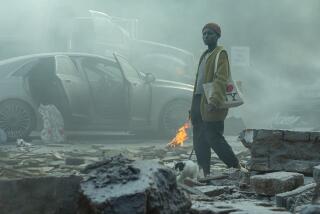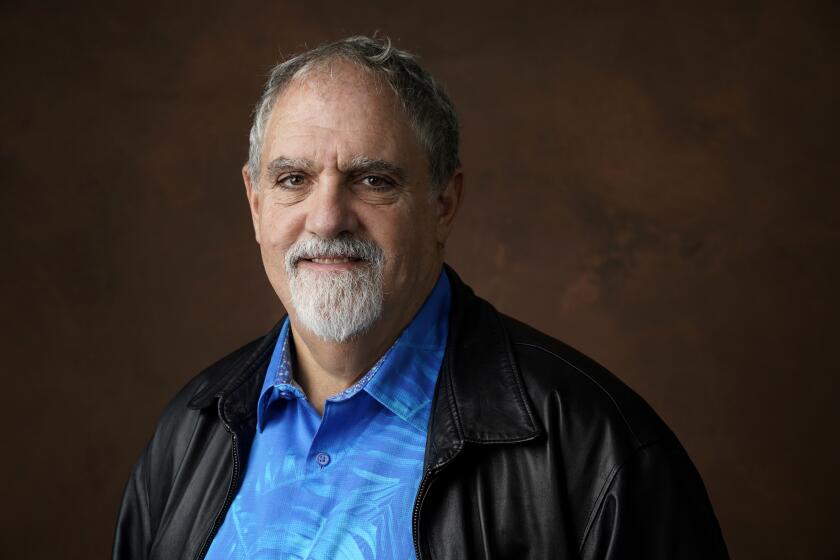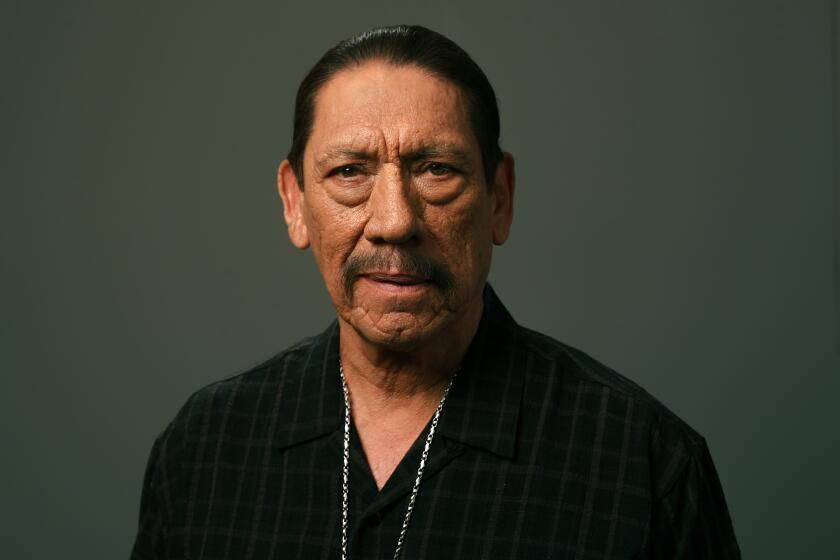There they go trashing L.A.
THE city of Los Angeles -- more precisely, the state of mind that is La-La Land -- is a big fat bull’s-eye for just about anybody who has ever felt pulled down by age and defeat. L.A. mocks the luckless, the unloved, the unappreciated. It also mocks the successful, since one is constantly surrounded by people who are far more favored than oneself. L.A. is mission control for the dream factory, so it’s no wonder Angelenos are enraged when their dreams go kablooey. City of Angels? Guess again. Those angels are furies.
The revivals featured in the “L.A. Destroys Itself” sidebar of the Los Angeles Film Festival -- “Earthquake,” “Escape From L.A.,” “Night of the Comet,” “Them!” and “Miracle Mile” -- are all disaster films of one sort or another. Not many of them are wonderful. The best is the little-seen “Miracle Mile,” a night-blooming doomsday thriller that, in one scene, offers up a quintessential ghastly funny Southland image: a fat rat plopping out of a palm tree.
The authentic L.A. disaster movie genre, in fact, is the film noir, in which the acids of sin and revenge seep into the groundwater and poison everything. The play of bright white and pitch black in a movie like “Double Indemnity” is a visual diagram of the sacred and profane, with the profane always winning out. These movies are saying don’t let all that sunshine fool you -- the soul of this city is dark, very dark.
One big reason the typical disaster movie, as opposed to the film noir, has never quite worked for L.A. is because, in the popular imagination, the city is already rotted out from the inside. Its demolition is redundant.
Go ahead. Try not to laugh.
THERE is usually, and often inadvertently, a comic undertone to the typical L.A. disaster movie. There has to be some payback for all that fun in the sun, and we get our kicks from figuring out who the victims will be, and in what order they will drop. (Usually minorities are the first to get offed, along with a token white star or two.) Characterization is kept to a soap-opera minimum. These are pawns, not people.
And then there are all those stilt homes and freeway curlicues just crying to come down. Compared to most great cities, L.A. is unmoored, prefabricated. The Botoxed, creaseless narcissists who incarnate La-La Land are also a species of fabrication. Bring them down too. It’s no accident that the archetypal dystopian L.A. movie is “Blade Runner,” in which the replicants and the humans are virtually indistinguishable.
Movies are a popular medium, and so it makes sense that Hollywood would draw on the hoariest L.A. cliches when visualizing its destruction: Movie agents, like cockroaches, survive the apocalypse, brokering deals in the inferno; the L.A. Memorial Coliseum becomes the Roman Coliseum, the Hollywood sign bursts into flame as if it were the burning bush. Workaday non-Hollywood types are not often given center stage in these films. Neither are the poor, particularly the non-white poor. The true L.A. disaster movie would be about illegal aliens, not aliens from outer space.
Although it’s nothing more than smart-alecky schlock, John Carpenter’s “Escape From L.A.,” set in 2013, is a useful compendium of I-Hate-L.A. cliches and also the only movie in the series that stirs the racial pot. In the aftermath of a 9.6 quake, the city, now an island, has become a deportation site for sinners -- i.e., hookers, atheists, meat eaters, smokers. (What -- no schlock filmmakers?) America’s president, played by Cliff Robertson at his most walleyed, is a religious zealot who welcomes the earthquake as the fulfillment of Armageddon. Meanwhile, a Che Guevara look-alike exiled on the island is orchestrating a Third World invasion of L.A. Is Carpenter buying into the notion of L.A. as Sin City or is he condemning it? Is he lampooning angry Third World immigrants or siding with their unrest? Who can say? He goes with whatever makes the biggest boom.
Decibel-wise, “Earthquake,” which will be shown in its teeth-chattering Sensurround, is the loudest boom machine in the bunch. It’s also the archetypal L.A. disaster movie, which is to say, it’s both indispensable and awful. There’s something oddly comforting -- guilt-free -- about watching an urban destructo orgy that will never be mistaken as a metaphor for 9/11. The opening moments serve up aerial shots of Los Angeles for our delectation -- like a death tease. When the quake finally hits almost an hour into the movie, it looks like nothing so much as a snit fit orchestrated by God. “We should never have put up those 40-story monstrosities,” penitent architect Charlton Heston bellows while plunging papier-mache girders pick off fleeing extras. (The horrific traffic snarl that ensues resembles any old afternoon on the 405 today.) The most seismic shock: Lorne Greene, seven years her senior, plays Ava Gardner’s father.
The God of “Earthquake” could not have had much of a sense of humor. All that vehemence just so we could watch a gaggle of movie stars get flattened! In film after film, Los Angeles is incinerated Old Testament-style for our sins. Doesn’t the deity have more pressing business? Maybe that old joke is true: What God really wants to do is direct. But why must he use L.A. as his back lot?
Actually, maybe God has moved on to other things. These movies haven’t really been made about L.A. for a decade. The featured films in the festival range from the mid-’50s to the mid-’90s -- well past the heyday for disaster flicks. With the exception of flare-ups like “Poseidon” or “The Day After Tomorrow,” the genre, which is certainly not confined to L.A., faded largely because the films were too pricey to produce. The advent of CGI effects could usher in a new era, as it already has with, say, gladiator and pirate movies, except that 9/11 has taken all the fun out of it. L.A. has plenty of new disaster movie targets -- the subway system, Walt Disney Concert Hall -- but what mogul has the stomach to explode them?
The only earthquake in the movies right now is the simulated one beneath the Vegas casino in “Ocean’s 13.” Charlton Heston dodging a boulder has been replaced by Al Gore at the lectern. Armageddon has gone global. In the disaster derby, L.A. is small potatoes.
--
Rainer is film critic for the Christian Science Monitor.
--
Destroy the place? A smashing idea.
Whether as commentary on the shallowness of L.A. and its wanton excesses, or just for the fun of seeing unfettered destruction, filmmakers, for a time, loved to target the City of Angels for mayhem. So pass the cheese as the Los Angeles Film Festival celebrates a city on the edge in its “L.A. Destroys Itself” series:
“Earthquake” (1974): When the Big One hits, Charlton Heston and company are heroic/ doomed survivors in a high-rise. 7:30 p.m. June 30, UCLA James Bridges Theater.
“Escape From L.A.” (1996): Kurt Russell portrays one-eyed outlaw “Snake” Plissken, sent to recover a doomsday device from a maniacal revolutionary in a lawless Los Angeles in this John Carpenter film. 9:30 p.m. next Sunday, Billy Wilder Theater at the Hammer Museum.
“Miracle Mile” (1988): Anthony Edwards and Mare Winningham are cast as a couple whose new romance might be cut short by nuclear missiles headed toward Los Angeles. 7:30 p.m. July 1, Italian Cultural Institute.
“Night of the Comet” (1984): Two Valley girls are among the few survivors of a comet that has either vaporized everyone else or turned them into zombies. 8:30 p.m. Saturday, Festival Promenade on Broxton Avenue.
“Them!” (1954): Atomic testing in New Mexico has spawned a horrifying nest of giant radioactive ants bent on decimating the human race. Can they be stopped before they attack L.A.? Stars James Arness. Noon July 1, Billy Wilder Theater at the Hammer Museum.
--
For tickets and more information, go online to www.lafilmfest.com.
More to Read
Only good movies
Get the Indie Focus newsletter, Mark Olsen's weekly guide to the world of cinema.
You may occasionally receive promotional content from the Los Angeles Times.






